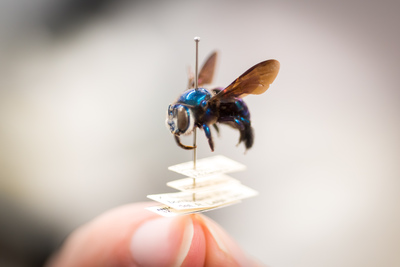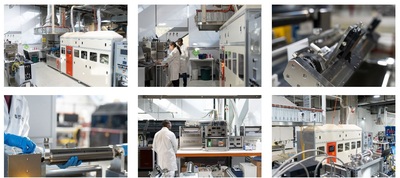New CSIRO facilities support biodiversity, membrane research

CSIRO has unveiled a state-of-the-art facility in Canberra to safeguard more than 13 million biodiversity specimens and support vital research to better understand and manage the natural environment. Named Diversity and opened on 14 August, the $90 million building features robust, temperature-controlled vaults that are bushfire- and pest-resistant, designed to preserve specimens from insects to wildlife while advancing scientific discovery.
Jointly funded by CSIRO and the Department of Education through the National Collaborative Research Infrastructure Strategy (NCRIS), the building brings together the Australian National Wildlife Collection and Australian National Insect Collection — collected over 150 years — under one roof, supported by cutting-edge laboratories and research infrastructure. The vaults contain:
- 55,000 birds, representing about 99% of Australian bird species (understood to be the most comprehensive collection of Australian and Papua New Guinean birds in the Southern Hemisphere);
- 17,000 orchids preserved in ethanol;
- 31,000 historical egg clutches from more than 1000 bird species;
- 37,000 tissue samples from more than 23,000 individual bird specimens (described as the world’s largest cryo-frozen tissue bank of Australian birds and one of the most significant collections of cryo-frozen Papua New Guinean bird tissues); and
- over 12 million Australian insects and related invertebrates (understood to be the largest collection in the world), including 2.4 million moths and butterflies and more than 7 million beetles.
CSIRO’s Chief Executive, Dr Doug Hilton, said the new facility would support researchers, government and industry to better monitor our environment, pests and weeds; to protect endangered species; to prevent disease; and to harness nature sustainably.
“For more than a century, our collections have quietly underpinned Australian science, policy, agriculture, biosecurity and biodiversity conservation … supporting everything from tracking pest incursions to discovering new species and understanding the genetic diversity of Australia’s native ecosystems,” Hilton said.
“This work contributes directly to the national interest. It informs biosecurity actions, climate resilience strategies and land management activities. It helps us answer one of the most pressing questions of our time: how do we protect biodiversity in a changing world?”
Toni Moate, CSIRO’s Director for National Collections and Marine Infrastructure, said Diversity is the newest purpose-built collections facility in the world, containing genomics laboratories and digitisation facilities that will allow scientists to extract and share more information from research specimens than ever before, connecting physical collections with digital platforms — from DNA sequences to high-resolution images.
“Our research teams here keep finding new ways to use our biological collections to create a better future for Australians — from using spider wasp venoms to source new pharmaceuticals, all the way through to using historic reptile collections to track how animals respond to climate change,” Moate said.
“This new facility will only accelerate this incredible work and enable us to move into new areas of research.”

Dr Clare Holleley, Director of CSIRO’s Australian National Wildlife Collection, added that the biodiversity collections serve as a library of life on Earth and a resource for caring for the environment, allowing scientists to better understand long-term trends in environmental response and to help prepare species for the challenges of the future.
“In this new building, we’re solving the problems that nature presents to us in real time,” Holleley said.
“Our researchers are often the very first people in the world to see a particular specimen, sequence a gene or put together pieces of the puzzle in a way never been done before — it’s incredibly rewarding.”
Architecture firm Hassell designed the building in close consultation with collections researchers and engineers over 10 months to ensure the design would enhance scientific capability and capacity, and preserve the delicate specimens for decades to come. Construction began in autumn 2022 and was completed just over two years later, while relocating the 13 million specimens to their new home took around a year.
Unlike museums, Diversity is a research facility and is therefore not open to the public. The collections are, however, accessible to researchers, governments and citizen scientists worldwide.
Pilot facility with Monash to fast-track membrane innovation
Just one day after the opening of Diversity, CSIRO joined Monash University in opening the Joint Monash–CSIRO Membrane Pilot Facility at the latter’s Clayton campus — described as a national-scale investment that supercharges Australia’s ability to translate world-class membrane research into real-world industrial solutions.
Membranes are essential to many future-focused industries, enabling everything from clean hydrogen production and energy storage to low-waste chemical processing and efficient water purification. The new facility is designed to bridge a critical gap between lab-scale breakthroughs and commercial deployment, and is housed within the Monash Centre for Membrane Innovation (MCMI).

Equipped with leading-edge instruments — including roll-to-roll membrane coating and casting systems, testing platforms for various membrane types, and high-precision electrochemical analysis tools — the pilot facility supports both short-term testing and long-term R&D partnerships, with access available to Monash researchers, other universities, government agencies and industry. According to Professor Matthew Hill, Director of MCMI, it is already being used by academic and industry researchers to refine scalable membrane designs and validate them under real-world operating conditions.
“This isn’t just a facility — it’s a national capability that will accelerate the development of next-generation membrane technologies in areas like water purification, green hydrogen and resource recovery,” Hill said.
“By embedding research excellence into infrastructure that can test, validate and scale emerging membrane technologies, we’re creating a launchpad for sovereign innovation and international collaboration.”
Dr Zongli Xie, CSIRO Group Leader, Materials for Energy, Environment and Health, said the facility represents a strategic expansion of Monash and CSIRO’s longstanding partnership in membrane science — a collaboration that underpins Australia’s global leadership in next-generation separation technologies for water, energy, critical minerals and circular economy applications.
“Together, Monash and CSIRO offer a complete innovation pipeline — from material design to membrane fabrication, optimisation and scale-up,” Xie said.
“This facility gives Australian science and industry a shared foundation to rapidly co-develop solutions for the most pressing resource and environmental challenges.
“The pilot facility is the latest chapter in a growing ecosystem that positions Australia as a global player in membrane innovation.”
Essential guidelines for storing flammable chemicals in a lab
Understanding the risks associated with storing flammable chemicals is crucial for maintaining a...
La Trobe launches AI medical research centre
The Australian Centre for Artificial Intelligence in Medical Innovation will leverage AI...
Plans unveiled for Australian Institute for Infectious Disease
The Victorian Government is investing up to $400m to deliver the institute, which is expected to...



